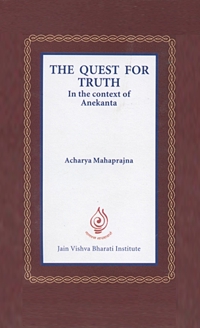
Jain philosophy is a spiritual philosophy. It accepts the independent existence of the soul. The spiritual philosophers have defined the soul in many and varied ways. Vedanta is one of the prime philosophies of India. That has explained the soul on the basis of the Upanishads. The Upanishads are a compilation of decades of thinking at the subtle level. The Upanishads are an echo of the intense reflection and attempts made to understand the profound secrets of creation. Vedanta is its representation. Its belief is that the mool atma or the source of the soul is one. The noun by which it is known is Brahman. That is the ultimate reality in the form of consciousness. All the sentient and the non-sentient of this real world emerge as modifications of this, mool atma. This is the principle of duality of consciousness. (chaitanya - dvaitavad). Those who base their philosophy on monism derived from non-sentience (jadaadvaitavadi) say that the material elements alone are real and consciousness is not a reality.
Exactly opposite to them are the philosophers who believe in monism based on the soul (atmadvaitavadi). They say the consciousness alone is real and not the material elements.
The materialistic monists say that the consciousness is created from matter. While the spiritual monists say that matter is created from consciousness. They both are contradictory to each other. Standing face to face with each other they oppose and decry the other.
Jain philosophy accepts the independent existence of the soul or reality of consciousness. But it does not deny the existence of the non-sentient. It believes in the existence of the sentient just as much as it believes in the existence of the non-sentient. Therefore it is not in conflict with jadaadvaitavadis but is located in the middle. It is inclusive of both the streams. It accepts both the independent existence of the sentient as well as the insentient. Its acceptance of both the ideas makes Jain philosophy dualistic: that which accepts the existence of the sentient and the insentient.
Thus three streams of philosophy have developed: jadaadvaitavad, atmaadvaitavad and dvaitavad. Indian philosophy is distributed between these three streams.
Some modern philosophers think Sankhya philosophy is very ancient and that Jaina philosophy is built on it. This I feel is a limited perspective. Sankhya philosophy is undoubtedly very ancient. But it should not be forgotten that Jaina philosophy is not less ancient. Sankhya philosophy and Jaina philosophy emerged from the same shramana tradition. Since they share a common ethos similarities between them can be explored but their chronology or dependence cannot be asserted. Sankaracharya wrote that Kapil's Sankhya philosophy was in contradiction to the Vedas and even to the texts of Manu which is in accordance with the Vedas. That is, it is against shruti or oral knowledge and smriti or remembered knowledge and so it is not worth considering or reflecting upon. A reference in the Padmapurana says that Nyaya, Vaishesika and Patanjali's yog philosophy are in contradiction with oral knowledge and therefore are not acceptable. I am amazed why scholars did not refer to these truths. Why were these factors not taken into account with respect to antiquity and articulation?
If you see Patanjali's yoga sastra you will find many words there which are similar to those found in shramana literature. They cannot be found in Vedic scriptures. Kevali, gyanavarniya, karma, samyag - gyan - samyag darshan, charamadeha, sopakrama, nirupakrama, savitark, savichar, nirvichar, etc. (omniscient, knowledge obscuring karma, right knowledge, right belief, the last embodiment of the soul, life span vulnerable to external effect, meditation based on verbal knowledge, meditation based on reflections, meditation free from reflections) are words found in great number in shramana literature. Sankhya and yoga are one stream of thought. The former is the philosophical aspect and the latter is the applied philosophical aspect. They both were not recognised in the Vedic tradition and therefore their harmony with the shramana tradition was natural. The shramana philosophy has laid great emphasis on the arhat. Jaina philosophy is the principal school of this trend. Sankhya, Aajivika and Buddhist philosophy belong to shramana tradition. In their exposition of truth, the long years of shramanic influence is embedded.
Jaina philosophy established dualism and sankhya too is dualistic. It established two realities: prakriti [matter] and purush [soul]. Jain philosophy established two realities: the sentient and the non-sentient. It is said that in this one can discern the influence of Sankhya philosophy over Jain philosophy. This belief is born out of inadequate knowledge of Jain texts. Scholars were familiar with the important text, Tatvarthasutra. But a text earlier to it by five or six centuries did not reach the scholars. If it had reached the scholars this thinking would have not arisen. Both Jain philosophy and Sankhya philosophy are dualistic and yet they have some fundamental differences. Sankhya philosophy believes that all creation is facilitated by prakriti. The main cause of creation is prakriti and because of prakriti all creation has taken place. Jain philosophy has defined creation as the co-ordinated action of both the sentient and the insentient. According to it only the soul or only pudgal cannot make things happen. Only their coordinated action makes creation.
 Acharya Mahaprajna
Acharya Mahaprajna


